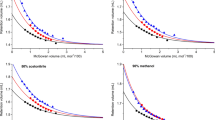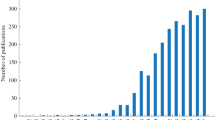Summary
The effects of the polar functional group of a solute on the r-value (the slope of the log-log plots of capacity factor vs. reciprocal of the organic solvent concentration in an aqueous binary mobile phase) and on the 1-octanol/water partition coefficient are compared, based on the linear solution energy relationship concept. Though both effects are closely related to the solute-solvent interaction, the effect on the partition coefficient depends on the difference in the abilities of the organic solvent and water to interact with the solute, while the effect on the r-value depends on the ability of the solute to interact with the solvent (especially water). The mobile phase composition, as far as it is in the intermediate range, causes little change in the effect of the polar functional group on the hydrophobic retention of the solute. Consequently, the r-value was confirmed to represent the hydrophobic interaction between the solute and ligand.
Similar content being viewed by others

References
C. Horváth, W. Melander, I. Molnár, J. Chromatogr.125, 129 (1976).
B. L. Karger, J. R. Gant, A. Hartkopf, P. H. Weiner, J. Chromatogr.128, 65 (1976).
A. Kaibara, C. Hohda, N. Hirata, M. Hirose, T. Nakagawa, Chromatographia,29, 275 (1990).
A. Kaibara, C. Hohda, N. Hirata, T. Nakagawa, J. Chromatogr. Sci.27, 716 (1989).
A. Kaibara, M. Hirose, T. Nakagawa, Chromatographia, accepted.
M. J. Kamlet, R. M. Doherty, M. H. Abraham, Y. Marcus, R. W. Taft, J. Phys. Chem.92, 5244 (1988).
M. J. Kamlet, J. M. Abboud, M. H. Abraham, R. M. Taft, J. Org. Chem.48, 2877 (1983).
M. J. Kamlet, M. H. Abraham, P. W. Carr, R. M. Doherty, R. W. Taft, J. Chem. Soc. Perkin Trans. II 2087 (1988).
R. F. Rekker, “The Hydrophobic Fragmental Constant”, Elsevier, Amsterdam (1977).
K. A. Dill, J. Phys. Chem.91, 1980 (1987).
S. C. Rutan, P. W. Carr, W. J. Cheong, J. H. Park, L. R. Snyder, J. Chromatogr.463, 21 (1989).
K. E. Bij, C. Horváth, W. R. Melander, A. Nahum, J. Chromatogr.203, 65 (1981).
N. El Tayar, A. Tsantili-Kakoulidou, T. Roethlisberger, B. Testa, J. Gal, J. Chromatogr.439, 237 (1988).
J. H. Park, P. W. Carr, J. Chromatogr.465, 123 (1989).
T. Braumann, J. Chromatogr.373, 191 (1986).
D. J. Minick, J. J. Sabatka, D. A. Brent, J. Liq. Chromatogr.10, 2565 (1987).
Author information
Authors and Affiliations
Rights and permissions
About this article
Cite this article
Kaibara, A., Hirose, M. & Nakagawa, T. Effect of the polar functional group of the solute on hydrophobic interaction with the stationary ligand in reversed-phase high-performance liquid chromatography. Chromatographia 29, 551–556 (1990). https://doi.org/10.1007/BF02261221
Received:
Accepted:
Issue Date:
DOI: https://doi.org/10.1007/BF02261221



